Document Review and Approval (wizard)
This tutorial describes how to create a document review and approval application using the Approval application wizard. The application you create with this wizard is a simple two step approval decision with rework process. For the first approval task recipient (the person who must respond to the task action), you enter the recipient's name as you complete the document approval form. The second approval task recipient is a static entry that you set with the wizard. The workflow process includes a rework task that allows either task recipient to send the document back to the originator for rework. After creating the application, you will test it by submitting two documents for review and approval.
The Document Review and Approval application you build in this tutorial includes a two step approval process with rework. After you submit the request form, the workflow routes to the first approval task. The task recipient (the person assigned the task) has three action options: Approve, Reject or Rework. If approved, the workflow routes to the second approval task recipient where again, they have three options: Approve, Reject or Rework. If either of the task recipients reworks the task, the workflow routes back to the workflow originator, or the person who submitted the request form and started the workflow. The workflow completes if the second approval task recipient approves or rejects the document.
Document Review and Approval Form
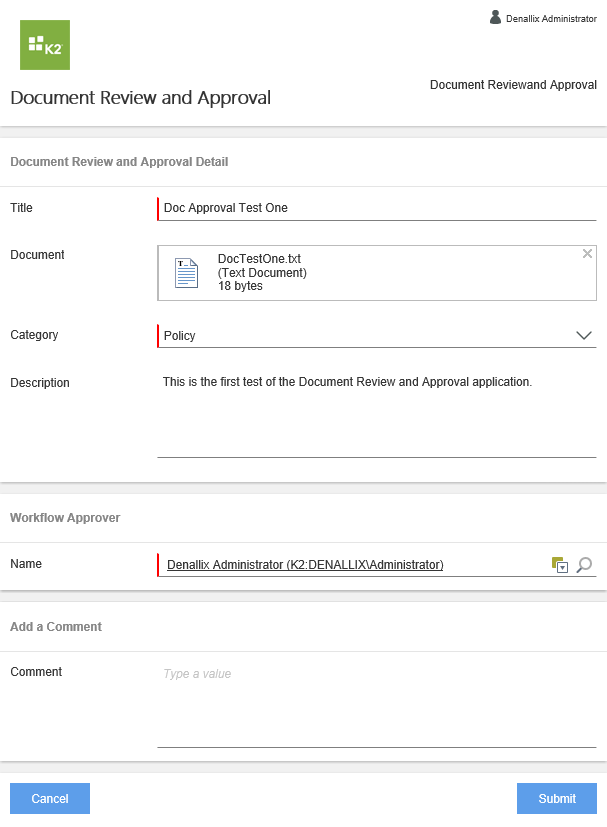
Apps are accessible through Workspace. Workspace is your personal dashboard for managing tasks assigned to you, viewing reports, managing personal settings (such as out-of-office and login credentials), and launching applications.
- Launch WorkspaceIf you are unsure of how to launch the Workspace site, see Accessing Sites.
-
The Workspace launches. You may see a welcome dialog which you can exit. If time allows, explore the Workspace features first, then launch the Apps workspace. To launch the Apps workspace, click the Nintex icon to expose workspace options. Click the Apps link to launch the Apps workspace.
- Workspace launches. In some environments, you will see a welcome dialog box.If you see the welcome dialog and would like to explore its contents, click START. Click NEXT on each screen until you reach the end, then click DONE. Otherwise, exit the dialog.

- You should now see the Workspace dashboard. The left-side column provides access to the workspace features. If time allows, take a few minutes to explore the Workspace. HOME
- The Home button provides quick access to the workspace landing page, or dashboard.
- The Inbox contains a display of tasks currently assigned to you. If the task was not configured to send a task notification email, you will not see it here. Clicking a task opens the associated form where you can complete the task.

- The My Forms page displays the forms (SmartForms) available for you to use.
- The Process Overview report provides a summary of process instances that you are associated with. For example, processes you started, or processes containing a task you actioned.
- The My Overview report displays a summary of your active and completed tasks. From this report, you can action tasks from the Active Tasks list.

- Here you can set your out-of-office controls, set-up auto logins, and set your default workspace.

- Click the Nintex icon to expose other workspace options. Click the Apps option to launch the application wizards menu.
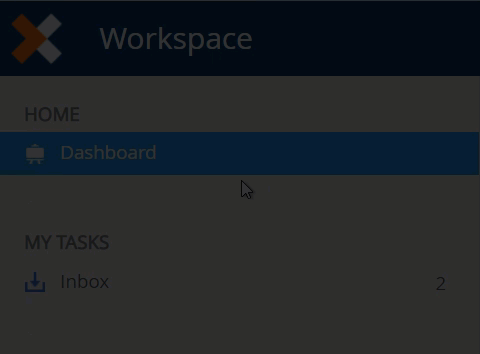
You may not have any apps just yet...
- Workspace launches. In some environments, you will see a welcome dialog box.
-
Use the Approval wizard to create an application that includes an approval workflow. Begin by clicking the Create a new App button in the All Apps screen. From here, select the Approval application wizard. Configure the general settings as follows, then click Next (Primary Detail):If there are apps already displayed in the central pane when you first open it, start from the BUILD > All > ALL APPS screen instead. Use the New button to start a new app.Each application title must be unique. You will see an error if you try to duplicate application titles. Consider adding your initials to the title so that you can easily determine which apps are yours. For example, Contact List [YourInitials], like Contact List KL.
Duplicate name error
- Name: Document Review and Approval
- Description: This is a test document review and approval process.
- Template Name: Document Approval
- First, you will add a new application. In the central pane, click Create a new App. (See the Note box below the image if you already have apps displayed in the central pane and don't see the create app link.)
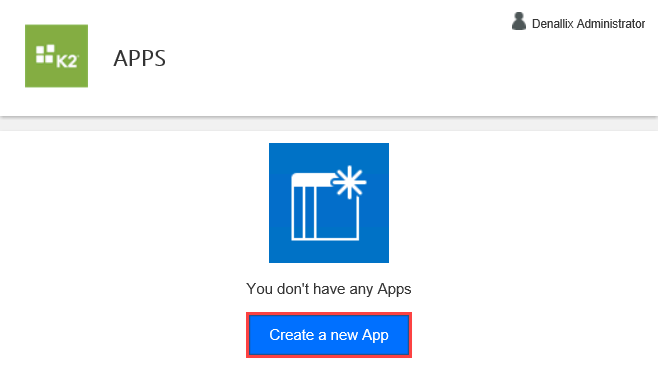
- You are on the NEW APP screen. Here, you can select the app type you want to generate or you can select the option to install an app from the catalog. (See the Install from Catalog tutorial for instructions on how to use this option.) For this tutorial, click the Approval option.

- You see a screen with general settings. At the top of the screen is a time-line that displays your wizard progress. Below that is a section where you can name your new application and give it a description.
Name the application
Document Review and Approval
then for the Description, enter
This is a test document review and approval process.Each application title must be unique. You will see an error if you try to duplicate application titles. Consider adding your initials to the title so that you can easily determine which apps are yours. For example, Contact List [YourInitials], like Contact List KL.
Duplicate name error
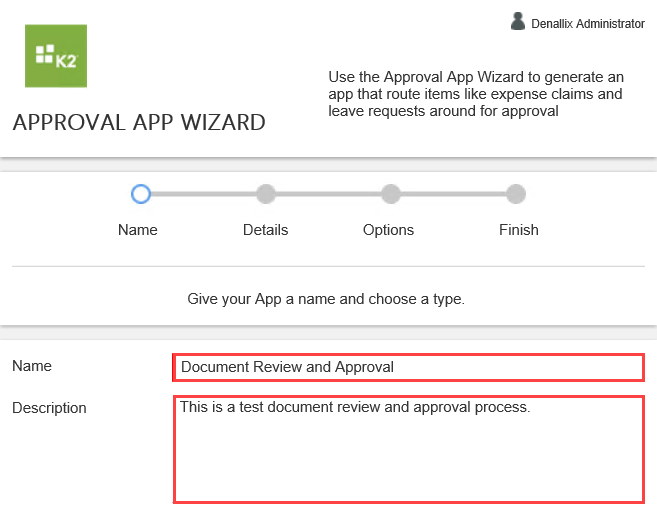
- Scroll down until you see the templates section. Here, you will find a list of approval-type templates you can choose from. Select Document Approval. To learn more about each template, you can open the template details and view the default overview, data object, and workflow structure for the template. Click More.
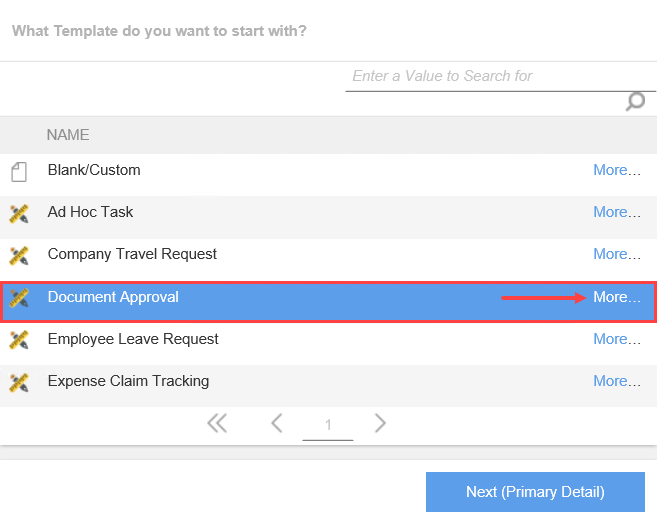
- The details for this template type open in a new browser window. On the Template Details screen, take a minute to explore the details available for the Document Approval template type. The Main Data Object screen displays the default properties for the SmartObject data source (such as Title, Document, and Category). The Workflow screen displays the default workflow template, a one-step approval. The Data Objects screen displays additional data sources for this template (there are none). Close the Template Details browser window.
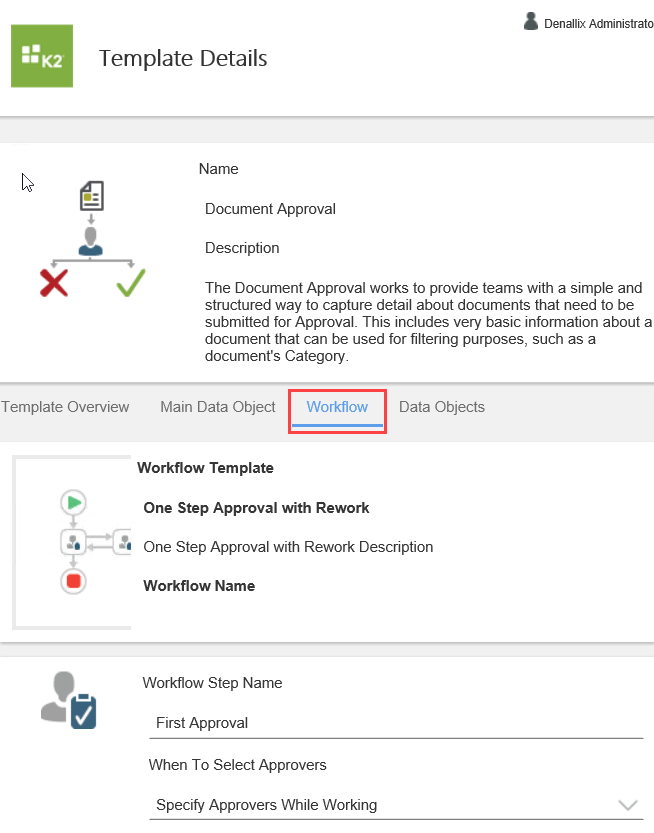
- Click Next (Primary Detail) to continue.
If you already have apps displayed in the central pane, you can start a new app from the BUILD > All > ALL APPS screen. Click All, then click the New button.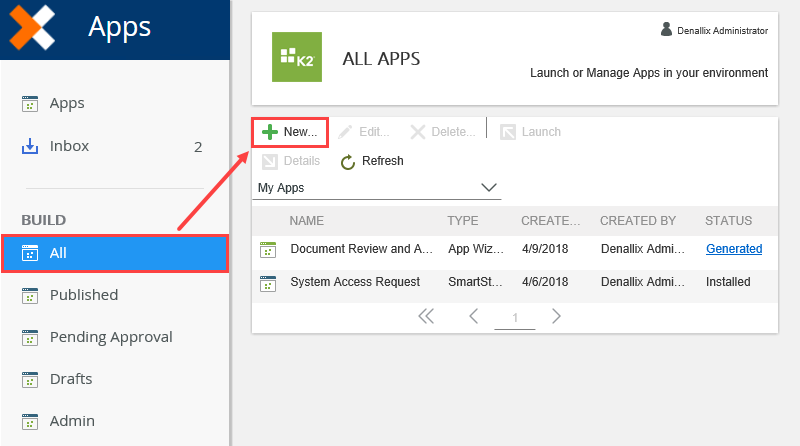
-
On the Main Data Object screen, you can add, edit or remove data fields. In the Document Review and Approval application, there are three required data fields and one optional data field. You can instantly determine required data fields by the red bar to the left of the data field name. Notice the Category data field is a lookup. You will change the category values.
Select the Category row, then click Edit. From the Available Options list, delete the default values, then enter the following values: Guideline, Policy, Procedure, and Standard.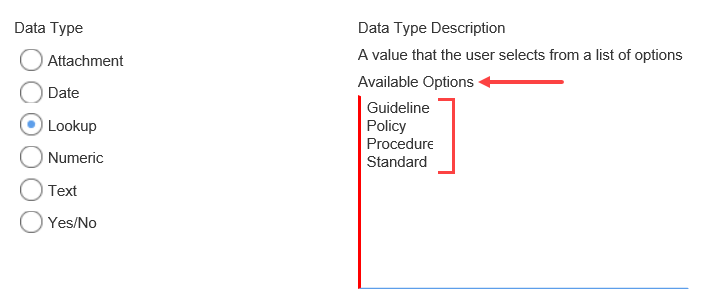
- Each app wizard template (such as Ad Hoc Task, Employee Leave Request, Document Approval) has its own set of predefined data fields. You can add, edit and delete data fields to customize the application for your own needs. In this step, you edit the lookup values for the Category data field. When you upload new documents for review, you can assign a category to the document. This helps keep your documents organized.
Select the Category row, then click Edit.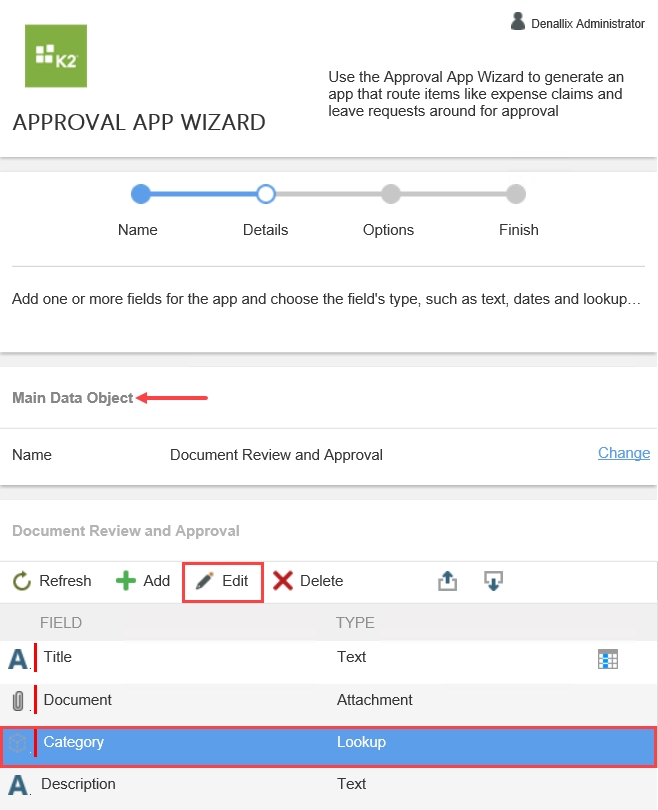
- In the Available Options list, notice the default categories. Highlight the default values and delete them. Replace the default values with the entries below, then click Done. Click Next (Additional Options) to continue.
Guideline
Policy
Procedure
Standard
- Each app wizard template (such as Ad Hoc Task, Employee Leave Request, Document Approval) has its own set of predefined data fields. You can add, edit and delete data fields to customize the application for your own needs. In this step, you edit the lookup values for the Category data field. When you upload new documents for review, you can assign a category to the document. This helps keep your documents organized.
- You are on the Workflow settings screen. Change the Workflow Template to Two Step Approval with Rework. Change the Workflow Name to Approval Workflow.
- Next, you will change the workflow template so that it is a two step approval workflow with a rework loop. You can think of the first approval task as a "review" task where you can choose the user you want to review your document. Think of the second approval task as an "approval" task that's assigned to a single user. Both task recipients can send the document back to you for rework if they choose. You can either resubmit the document or cancel the review request.
Click the Workflow Template > Change link. On the Select a Workflow Template page, select Two Step Approval with Rework, then click Select.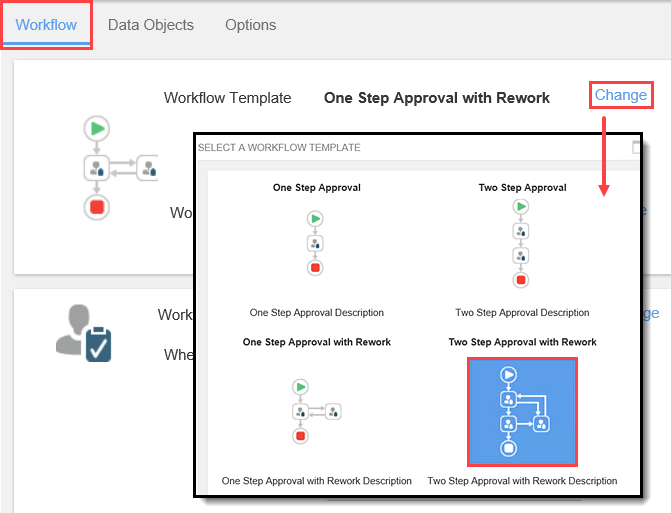
- Change the name of the workflow so that it's more meaningful. Click Workflow Name > Change, then change the workflow name to
Approval Workflow
then click Update.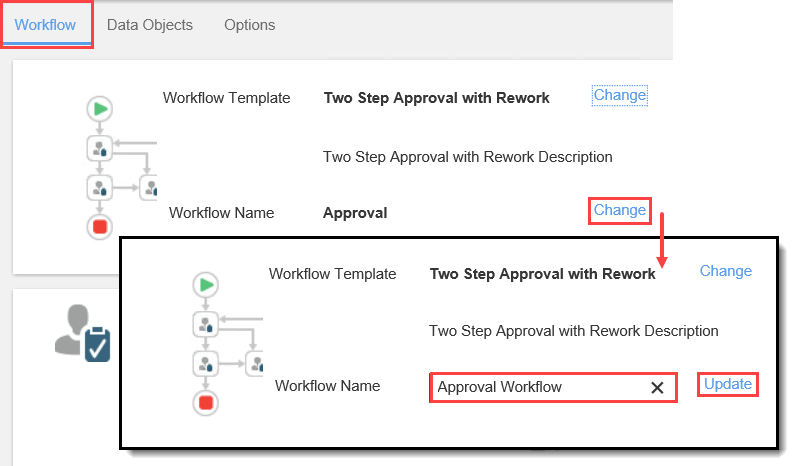
- Next, you will change the workflow template so that it is a two step approval workflow with a rework loop. You can think of the first approval task as a "review" task where you can choose the user you want to review your document. Think of the second approval task as an "approval" task that's assigned to a single user. Both task recipients can send the document back to you for rework if they choose. You can either resubmit the document or cancel the review request.
- Next, you will configure the task recipients for the approval tasks. The first task is more of a "review the document" task, so you will pick the person you want to review the document when you are filling out the request form. In the real world, this person might be a co-worker that you can call upon to review the document before you submit it for approval. The second task is the "approval" task and this recipient is a static value that you will set now. In the real world, this person might a part of a quality assurance team, or human resources team, responsible for document accuracy and consistency.
The First Approval recipient should be set to Approvers will be selected when workflow is started by default. This is correct. You will enter the user recipient as you complete the form. Set the Second Approval recipient to Bob Maggio.Assign your own user account or a co-worker’s account, so that you or they can action the task when testing the application.- As noted above, the First Approval recipient is already set to Approvers will be selected when workflow is started. For the Second Approval recipient, select the Specify Approvers option, then enter
Bob Maggio
into the search box and click the Resolve icon. You should see Bob's name underlined along with his email address. Click Next.Assign your own user account or a co-worker’s account, so that you or they can action the task when testing the application.
- As noted above, the First Approval recipient is already set to Approvers will be selected when workflow is started. For the Second Approval recipient, select the Specify Approvers option, then enter
- Generate the application artifacts.
- Notice the time-line indicates the wizard is complete. At this point, you are ready to generate the artifacts for your Document Review and Approval application. K2 artifacts are the objects that make up an application and include: views, forms, SmartObjects, workflows, and any underlying service types and settings.
Click the Generate App button. K2 creates the artifacts using the wizard settings you just configured. Depending on the complexity of your application, the generation process can take several minutes.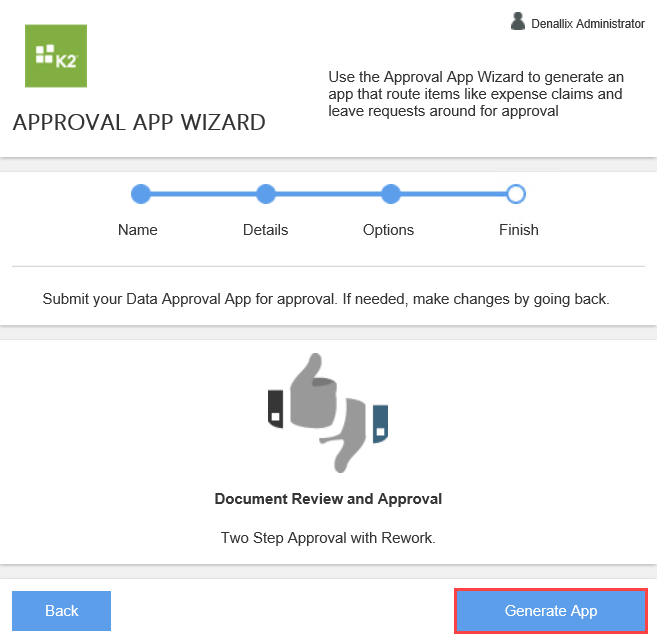
When the application generation process completes, you are on the Document Review and Approval landing page. (This may take a few seconds to redirect. Wait until K2 redirects you to the Document Review and Approval landing page before continuing.)
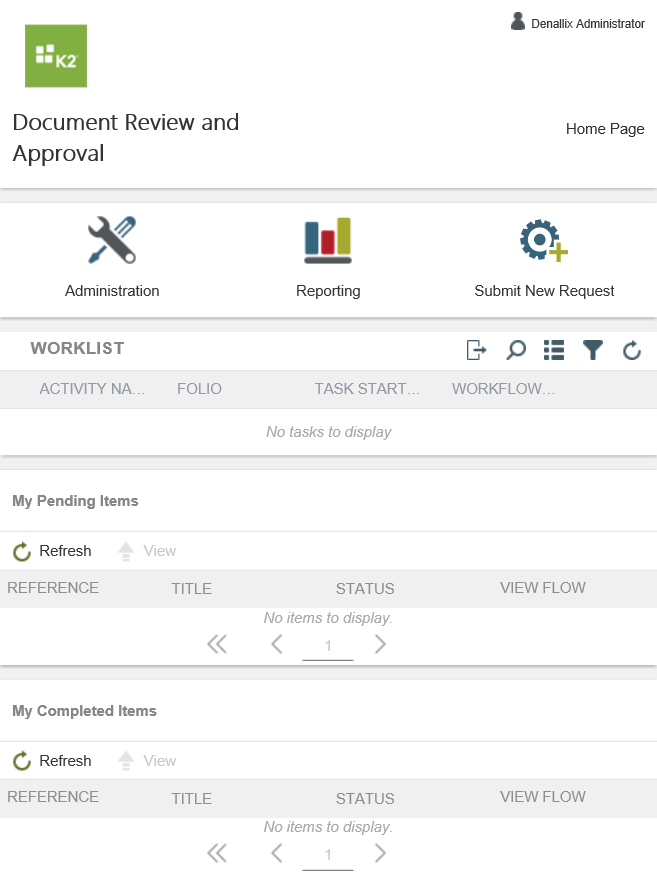
- Notice the time-line indicates the wizard is complete. At this point, you are ready to generate the artifacts for your Document Review and Approval application. K2 artifacts are the objects that make up an application and include: views, forms, SmartObjects, workflows, and any underlying service types and settings.
- In this step, you will use your new application by submitting two document approval requests. For the first request, you will approve the first approval task which sends the workflow on to Bob Maggio (or the user you assigned) for the second approval task. As "Bob", you approve the second approval task, which completes the workflow. For the second request, you will rework the approval task to send the workflow back to the originator (you!) for rework and resubmit. You will then resubmit the request.
Click Submit New Request.- You will submit two new document approval requests to test your new application. After you submit the requests, you will navigate to the Document Review and Approval landing page. Here, you approve one request and send the other request back for rework. For the approved request, you will open K2 Workspace for Bob Maggio (or the user you assigned as the recipient). "Bob" approves the second approval task and the workflow completes. Begin by clicking Submit New Request.
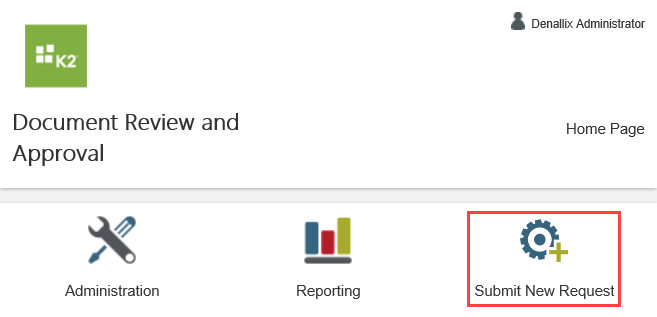
- You will submit two new document approval requests to test your new application. After you submit the requests, you will navigate to the Document Review and Approval landing page. Here, you approve one request and send the other request back for rework. For the approved request, you will open K2 Workspace for Bob Maggio (or the user you assigned as the recipient). "Bob" approves the second approval task and the workflow completes. Begin by clicking Submit New Request.
- Submit your first document approval request. Complete the form fields as follows:
- Document Review and Approval Detail
- Title: Doc Approval Test One
- Document: Upload any document you like. If necessary, create test documents in Word or NotePad.
- Category: Policy
- Description: This is the first test of the Document Review and Approval application.
- Workflow Approver
- To keep it simple, use your own account to action the first task. If using a K2 VM, use Denallix Administrator.
- Before continuing, you may want to create two or more test documents, then save them to the desktop. Use Word or NotePad. This gives you documents to add to your request.
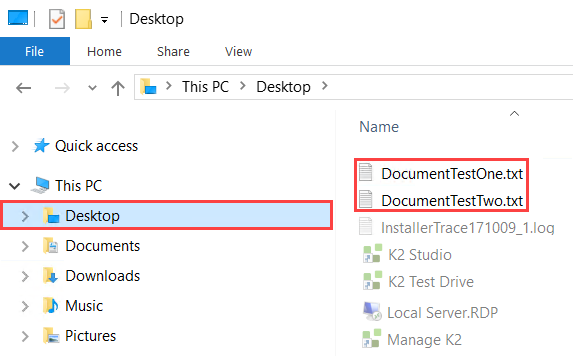
- On the new request form, complete the form fields. For the Title, enter
Doc Approval Test One
then for the Category, select Policy. For the Description, enter
This is the first test of the Document Review and Approval application.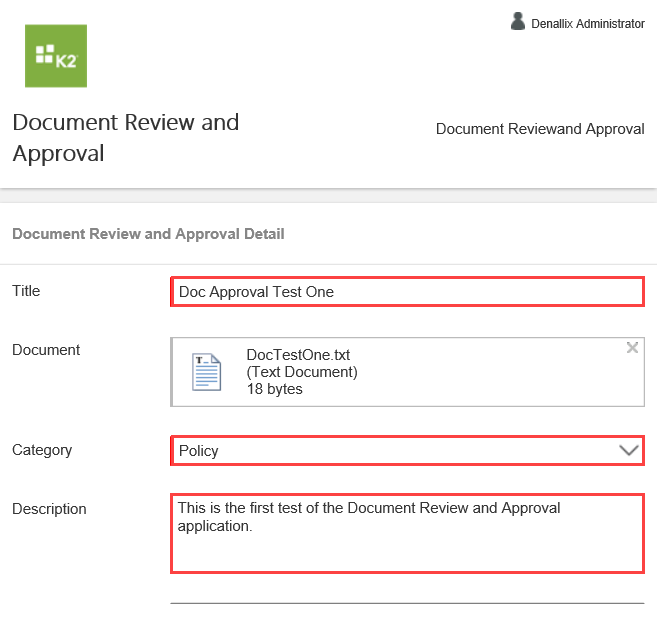
- For the Document, click inside the file attachment box, then browse to and select your first test document. Click Open to attach the document.
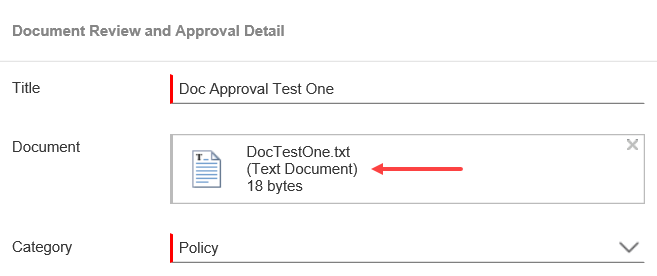
- Next, you enter a task recipient for the first approval task. Recall that the first task recipient can be any user you choose. The second task recipient is a static value, Bob Maggio (or the user you assigned). To keep things simple, enter your own name as the first task recipient. If you are working on a K2-provided VM, enter
Administrator
for the Name value under the Workflow Approver heading. If you are working on your own environment, enter your own name. Click the Resolve icon the set the value. The value is set when you see the account name underlined.
- Your form should look like the image below. Click Submit.

- Document Review and Approval Detail
- Submit the second document approval request. Use the following as a guideline:
- Document Review and Approval Detail
- Title: Doc Approval Test Two
- Document: Upload any document you like. If necessary, create test documents in Word or NotePad.
- Category: Standard
- Description: This is the second test of the Document Review and Approval application.
- Workflow Approver
- Once again, this is for the first task. To keep things simple, enter your name. If on a K2 VM, enter Administrator.
- Next, you submit the second document approval request. Click the Submit New Request button.
- Complete the form fields. For the Title, enter
Doc Approval Test Two
then for the Category, select Standard. For the Description, enter
This is the second test of the Document Review and Approval application.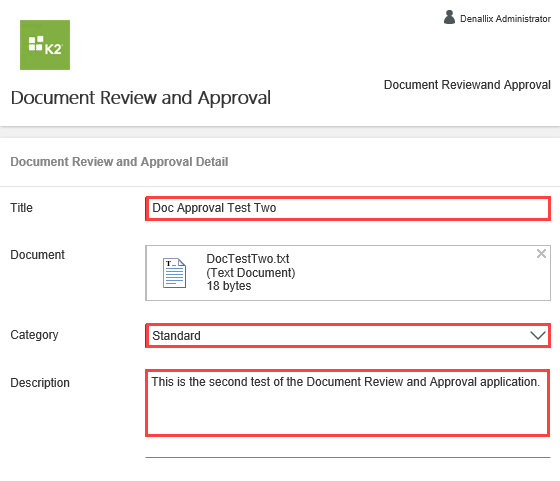
- For the Document, click inside the file attachment box, then browse to and select your second test document.
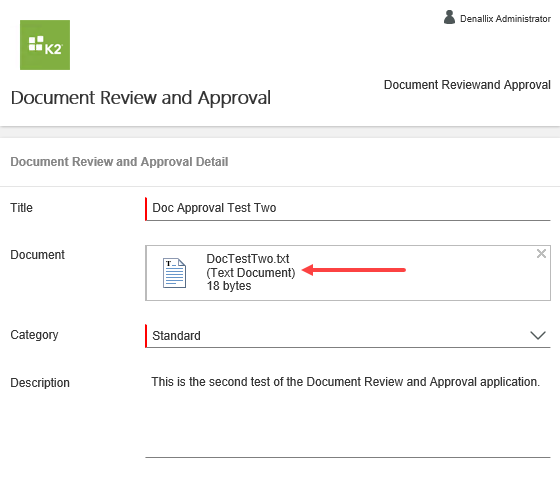
- Once again, to keep things simple, you enter your own name for the Workflow Approver value. If you are working on a K2-provided VM, enter
Administrator
for the Name value under the Workflow Approver heading. If you are working on your own environment, enter your own name. Click the Resolve icon the set the value.
- Your form should look like the image below. Click Submit.
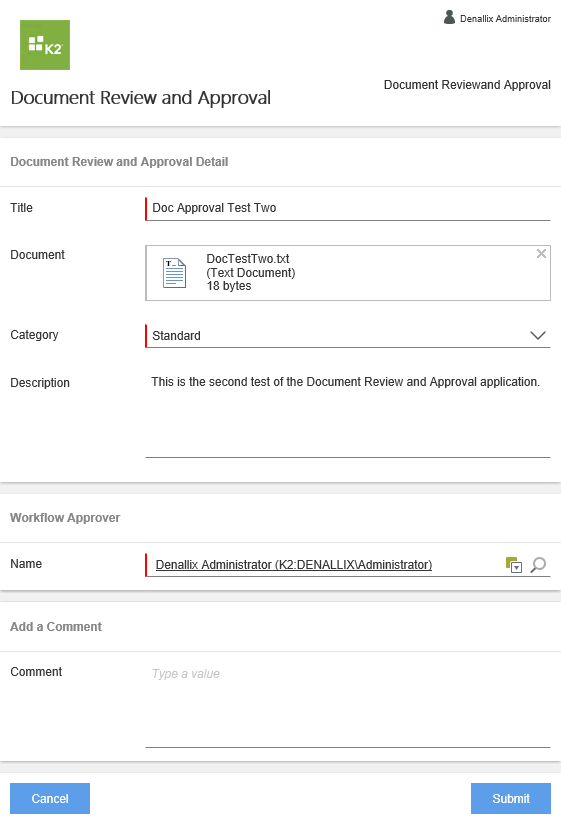
- Document Review and Approval Detail
- You are on the Document Review and Approval landing page. Open the View Flow report for the first process instance (in the My Pending Items pane). Review the current state of the workflow for that instance. Notice the workflow pauses at the first approval task, Initial Request Review. This is the first approval task assigned to you. Return to the landing page, then open the form for the second instance in the Worklist pane. Approve the request. Open the form for the first instance, and select Rework. (You don't have to follow the form order exactly, the results end nearly up the same.)

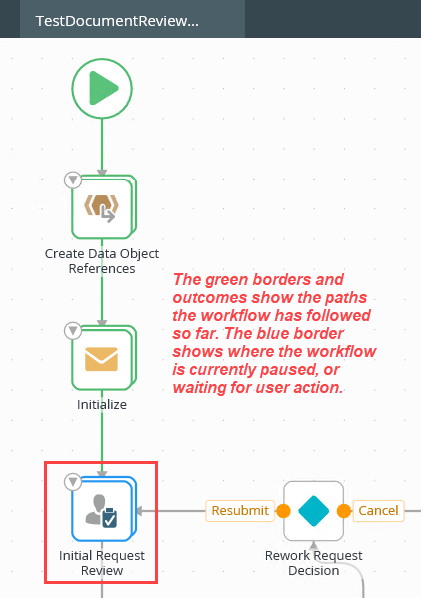
- Notice the Worklist pane has two entries, one for each of your requests. The two instances show up here because you set yourself as the first approval step task recipient, so you now have two tasks assigned to you, one for each workflow started. Further down the page, notice the two instances in the My Pending Items pane. These are also the two instances you started. Click the View Flow link for one of the instances.
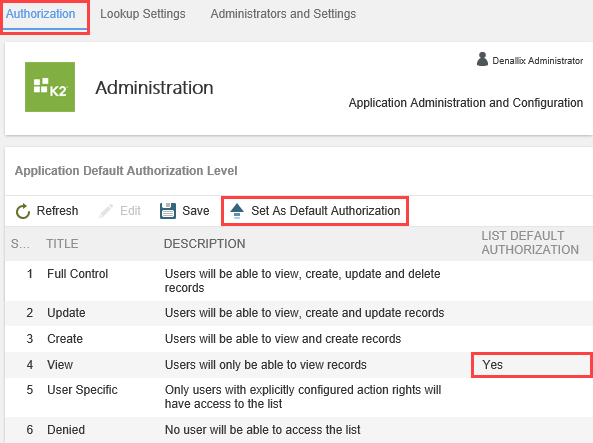
- Return to the landing page. In the Worklist pane, expand the context menu arrow for the second instance. Click Open Form. Note that your list may be sorted in descending order.
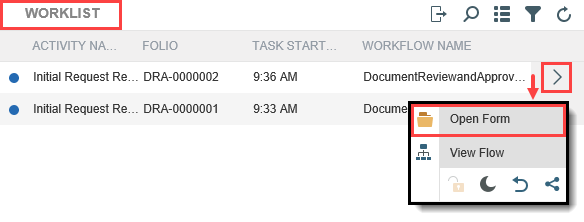
- The form opens. Here, you can review the form fields, open the attached document, and select an approval decision (Approve, Reject or Rework). Notice too, the fields are read-only. Because you are reviewing the form entries, you do not need to change any of them. Open the document if you like, then select Approve for the Decision value. Click Submit to send your decision. Click OK for the confirmation dialog. (Depending on your K2 version, you may not see a confirmation dialog.)
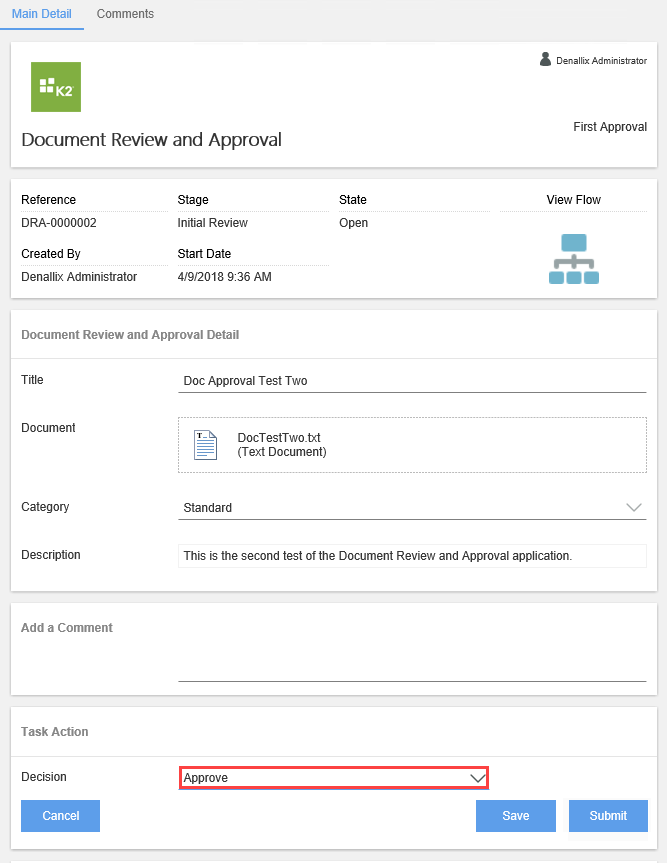
- Back on the landing page, open the form for the first process instance. Review the contents, then select Rework for the Decision. Submit the form.
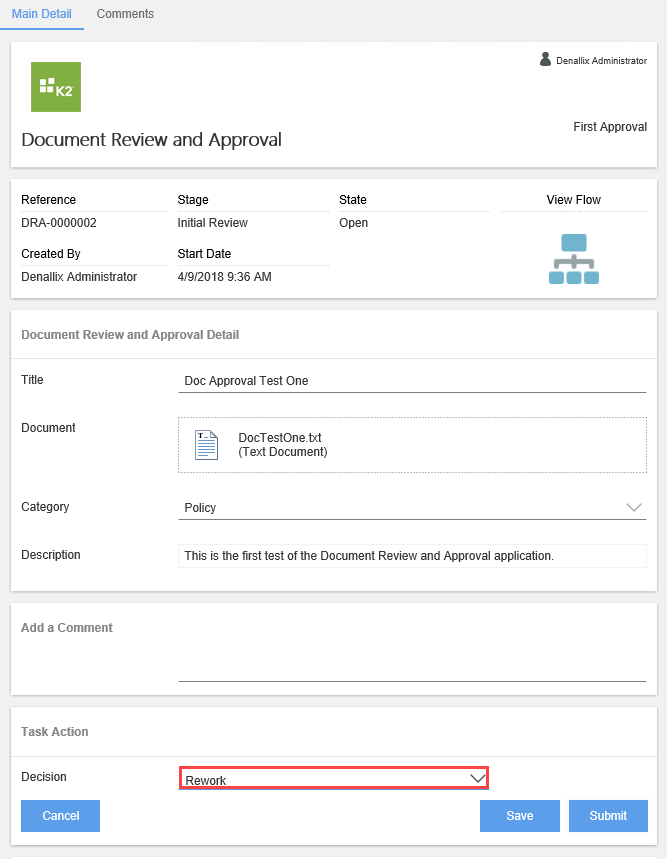
- Open the View Flow report for the second instance. This is the instance where you approved the first approval task. You should see the workflow paused at the second approval task. This is the approval task assigned to Bob Maggio (or user you assigned). Close the View Flow report.
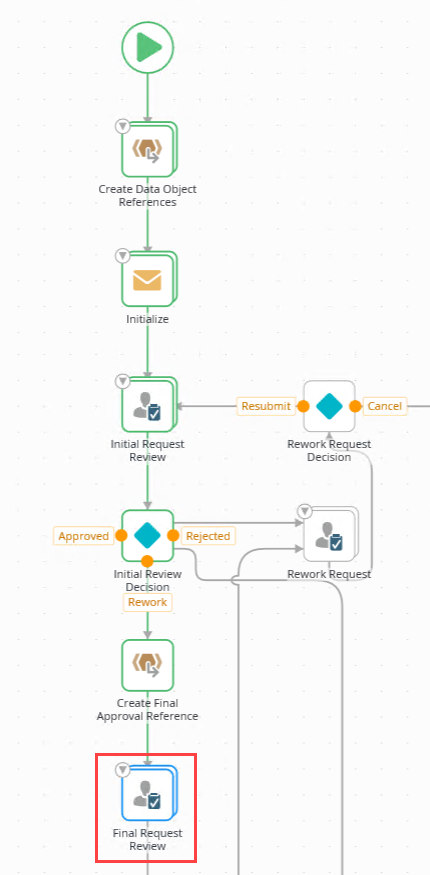
- Back on the landing page, you should see only one process instance in the Worklist pane. You approved one instance, and that instance is now in Bob Maggio's Worklist (or assigned user), waiting final approval. The Worklist instance you see now is the Rework instance, which has been sent to the workflow originator (you!) for rework, then resubmit. Notice the My Pending Items pane shows you the current status of both instances.
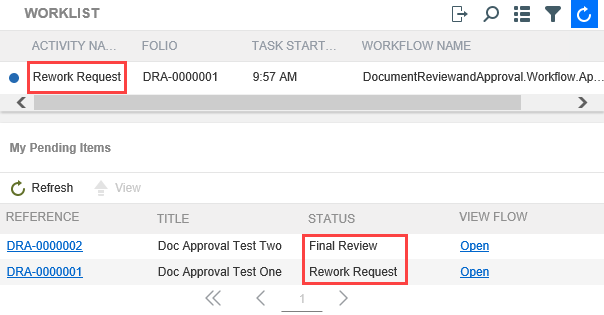
- From the Worklist pane, use the context menu to open the form for the Rework Request instance.

- Review the form contents, then select Resubmit for your decision. Submit your decision.

- Refresh the Worklist pane. Notice now, the activity has changed back to the first approval task (Initial Request Review). The workflow loops back to the beginning and starts the approval task all over again. This looping effect can repeat itself as many times as necessary, until the recipient selects a different decision. You won't take action on this instance any further. This gives you content for the reporting steps.

The View Flow report gives you a visual representation of the current state of the workflow. Green borders and outcome lines show the completed paths the workflow followed. Blue borders show where the workflow is currently paused, for example, at a task step waiting for user interaction. Close the View Flow report.

- Notice the Worklist pane has two entries, one for each of your requests. The two instances show up here because you set yourself as the first approval step task recipient, so you now have two tasks assigned to you, one for each workflow started. Further down the page, notice the two instances in the My Pending Items pane. These are also the two instances you started. Click the View Flow link for one of the instances.
-
In this step, you open Bob Maggio's K2 Workspace and action the request as Bob. Use the User Shortcuts to open an IE browser for Bob, then launch K2 Workspace from the computer's start menu. Bob can be found in the Finance group. If you are working in your own environment, action this task for the recipient you configured. After you action the task, confirm the task appears in the My Completed Items section on the Document Review and Approval landing page. (Optional) Open the View flow report for the completed item and review the workflow paths.
- To view Bob's worklist, you need to launch a version of K2 Workspace as Bob. You review his worklist, then action on the task assigned to him. Recall that Bob Maggio is a static value you entered for the second approval task recipient. If you are using a K2 VM, click the User Shortcuts link in the lower right corner of your screen. (If in your own environment, you will need to contact the user you entered for the second approval task recipient when configuring the application wizard.) Expand the Finance group, then click IE (Bob) to launch a browser in Bob's name.
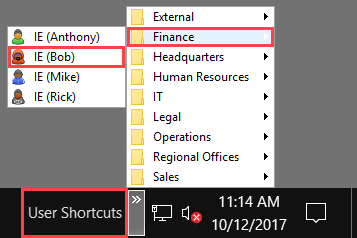
- With Bob's browser the active browser (on top of all other open windows), launch another instance of K2 Workspace. (Using the start menu: Start > K > K2 > K2 Workspace. Using a URL: https://[K2Environment]/workspace. For example, https://k2.denallix.com/workspace.) If you see a login prompt, enter
Username: Denallix\bob
Password: K2pass! - K2 Workspace opens in Bob's name. Click Inbox, found in the MY TASKS pane.
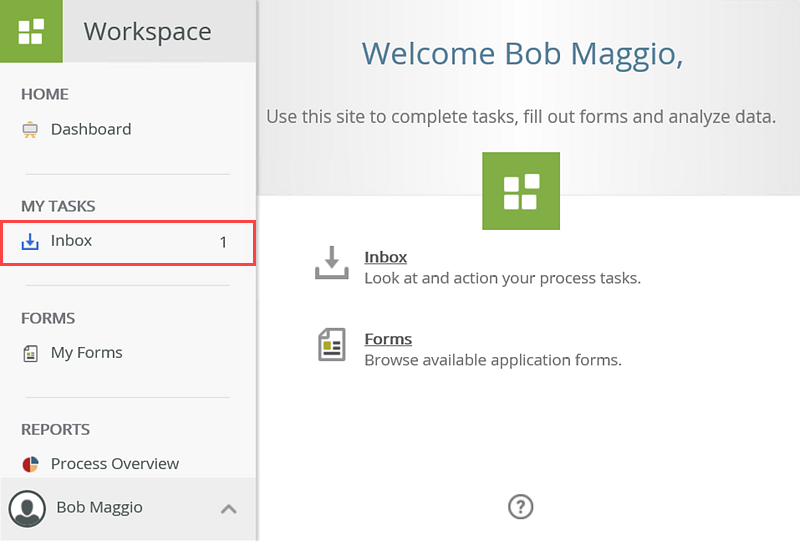
- Find the task notification email called Final Request Review. Click the email title to open the task form in the central pane.
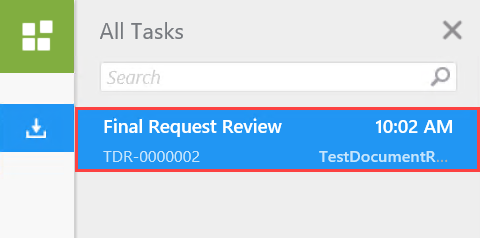
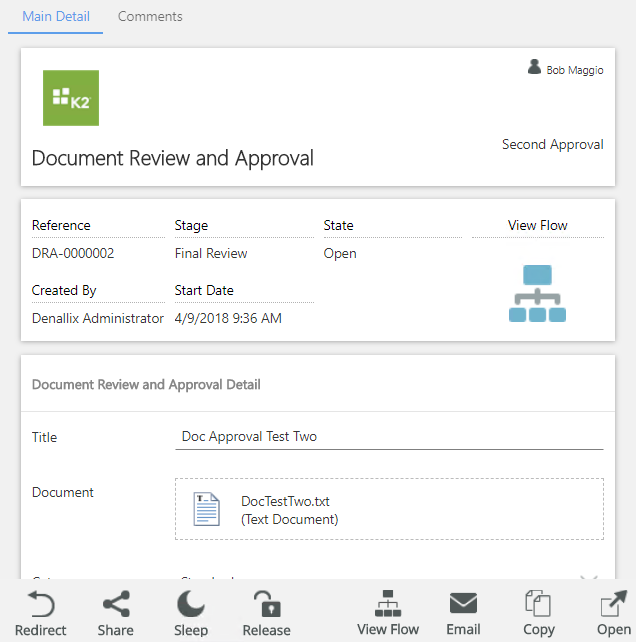
- From here, you action the task by selecting either Approve, Reject or Rework. You can also redirect the task to another user, sleep the task (pause it) or share it with another user. For this step, select Approve, then Submit. Minimize Bob's IE browser.
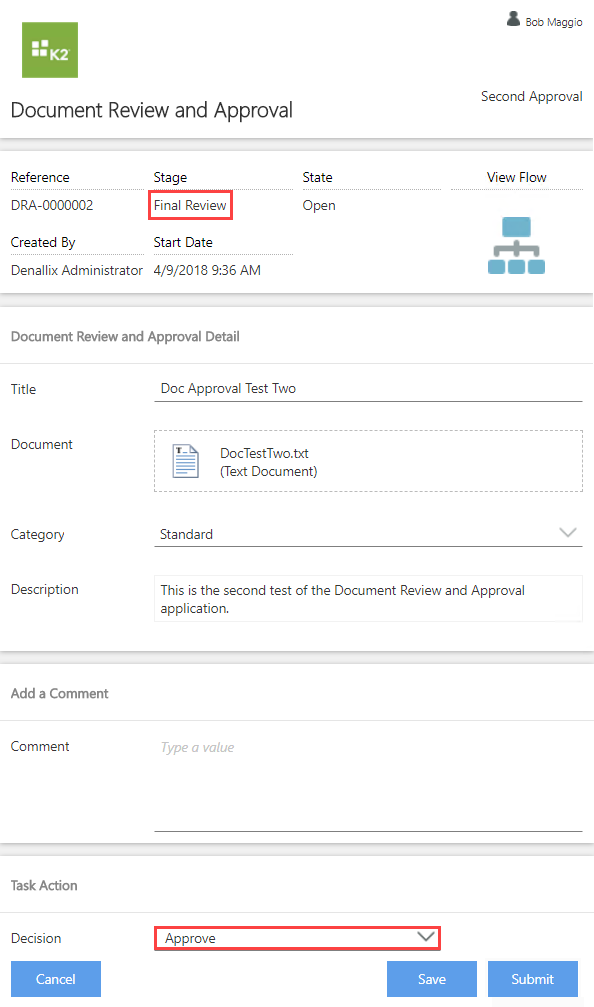
- Return to the Document Review and Approval landing page (as Administrator, or yourself). Refresh the page. At the bottom of the page, locate the My Completed Items pane. Notice the instance that Bob approved appears in this list. Since Bob approved the task, the workflow is complete. Click the View Flow link for this instance.You may find yourself on the APPS landing page instead of the Document Review and Approval landing page. If this is the case, click the All link under the BUILD heading in the left column. Then select the Document Review and Approval application in the central pane and click the Launch button.
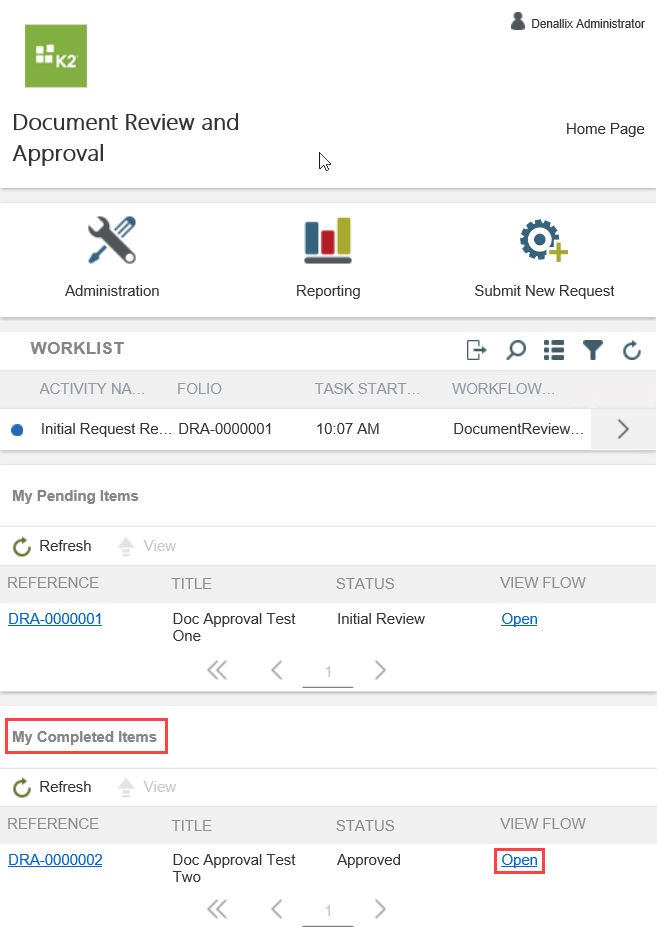
- Review the View Flow report. Notice the green path travels from start to finish as this workflow is now complete. Close the View Flow report.
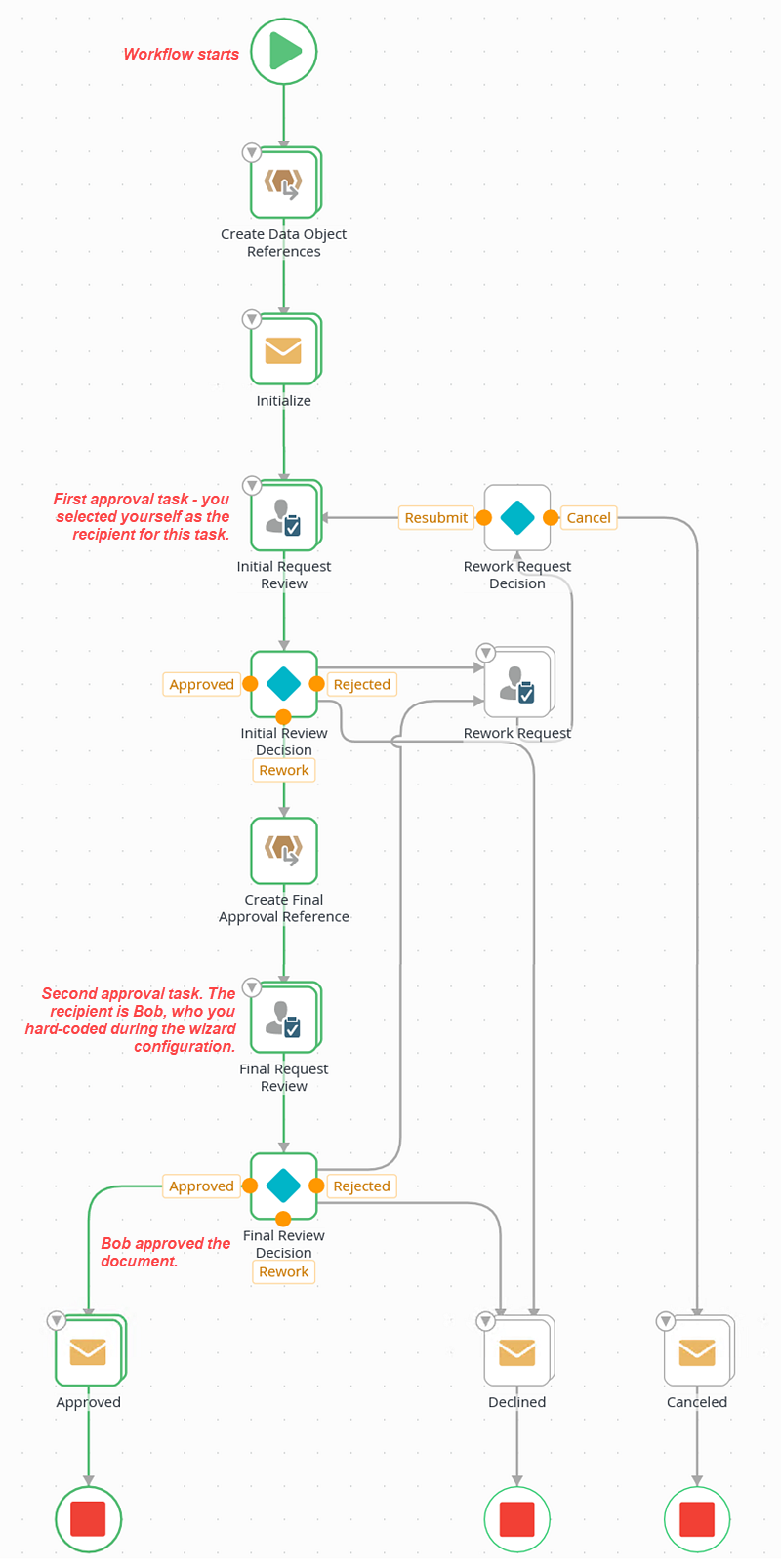
- To view Bob's worklist, you need to launch a version of K2 Workspace as Bob. You review his worklist, then action on the task assigned to him. Recall that Bob Maggio is a static value you entered for the second approval task recipient. If you are using a K2 VM, click the User Shortcuts link in the lower right corner of your screen. (If in your own environment, you will need to contact the user you entered for the second approval task recipient when configuring the application wizard.) Expand the Finance group, then click IE (Bob) to launch a browser in Bob's name.
- In this section, you learn about reporting features for the Document Review and Approval application.
The Document Review and Approval application has two reports: Process Overview report and Export to CSV report. Launch the Document Review and Approval application so that you are on the application landing page. (You may already be there.)- If you are not on the Document Review and Approval landing page, begin by clicking All from the BUILD section in the left column. In the central pane, select the Document Review and Approval application, then click Launch. (Your list of applications may not be the same as the image below.)
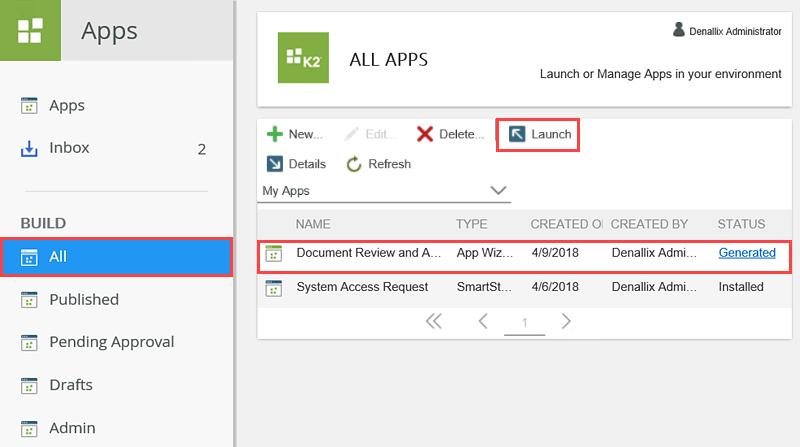
- If you are not on the Document Review and Approval landing page, begin by clicking All from the BUILD section in the left column. In the central pane, select the Document Review and Approval application, then click Launch. (Your list of applications may not be the same as the image below.)
-
You are now on the Document Review and Approval landing page. Open the Reporting options. Open the Process Overview Report. On the Process Overview page, notice the overview bar. The overview bar provides a summary of the instance activity, including the number of processes, active processes, the number of errors and the time that has lapsed since the last activity. Take a few minutes to explore the different report options on this page. Notice that you can view the charts in day, week, or month blocks. For more details on this report, expand the section below.
- On the Document Review and Approval landing page, click Reporting.
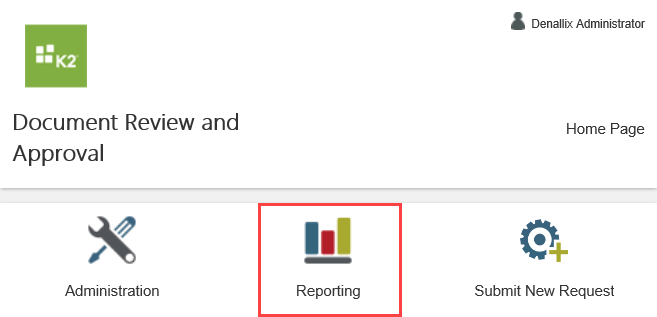
- Click the Process Overview Report option.
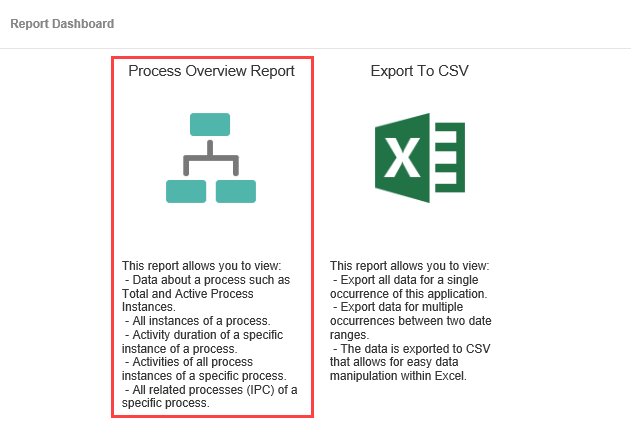
- The Process Overview Report displays data for all instances of the document review and approval application. At the top of the report is an overview bar that provides a summary of instance activity. You can tell at-a-glance the total number of process instances, number of active instances, number of active tasks and instances that are in error. Some tasks have escalations configured for task steps. Escalations are reminders that a task is past due and can be as simple as an email, or more complex where the task is redirected to another user.

- Instances Started: This is a chart that you can view in day, week or month blocks. As you build more workflows and this report has more content, you should be able to see trends in when users are starting instances of the Test Document Review and Approval application. Keep in mind your screen views may not match the reporting images exactly. Some images reflect multiple approval applications submitted over several days. This is only to give you an idea of what the reports look like.
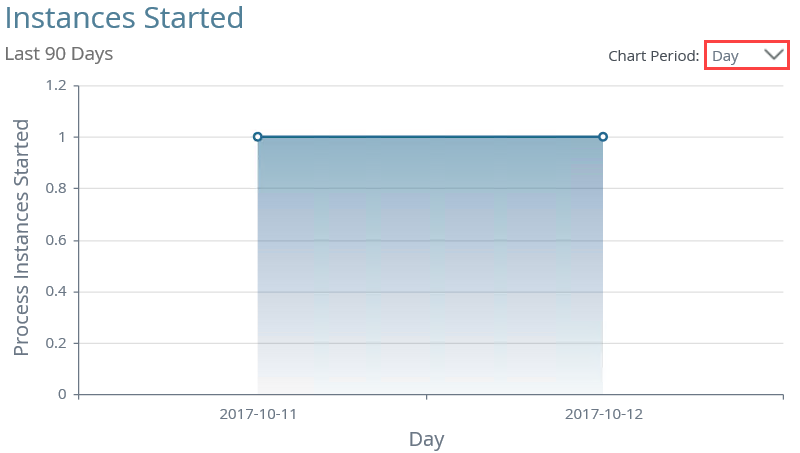
- All Instances: This is a spreadsheet view that provides data on all document review and approval process instances whether active, in error or complete. This section is especially useful as you can drill down into more detailed reports by clicking the ID link. You can also launch the View Flow report for a single instance.

- Activity Duration: This bar chart shows the average duration of a completed activity. If you have a workflow with many user tasks (your application has three), this report allows you to view which tasks are taking longer. You can then rework the workflow or add escalations to complete the workflow in a timely manner.
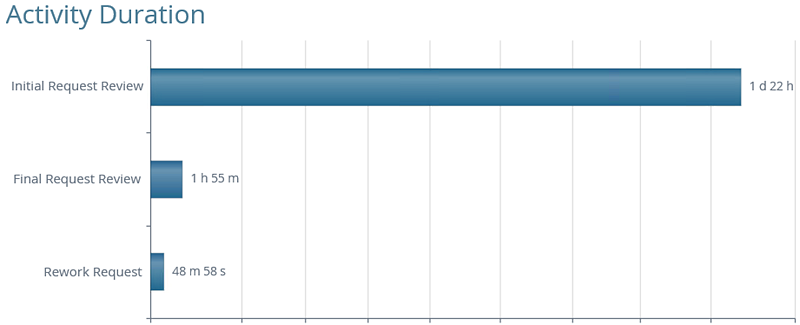
- Activities: This combination chart and list displays all the steps for the workflow. (Steps are also known as activities.) By default, only user tasks appear in the left column. User tasks require human interaction of some kind, such as making a decision (approved, rejected). The K2 server performs system tasks behind-the-scenes, such as sending emails or updating content. The Include System Activities box in the upper right corner adds system tasks to the left column, in addition to the user tasks. In the upper left side of your screen is a drop-down menu where you can select to view all, active or completed instances. After clicking the step name, the details appear in the central pane.
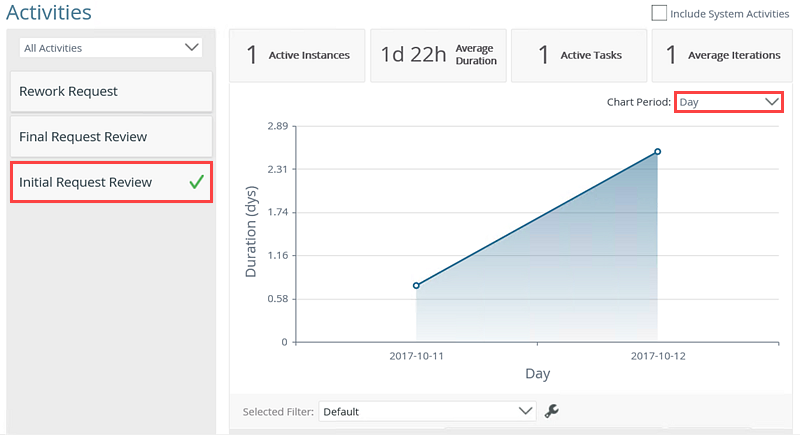
- Related Processes (IPC): If a workflow instance has a sub-workflow associated with it, the sub-workflow appears in this section.
You have two options for reports: Process Overview Report and Export to CSV. Export to CSV allows you to export reporting data in CSV format, where you can further analyze the data or create charts in software such as Excel. You will not work with the Export to CSV report in this tutorial.
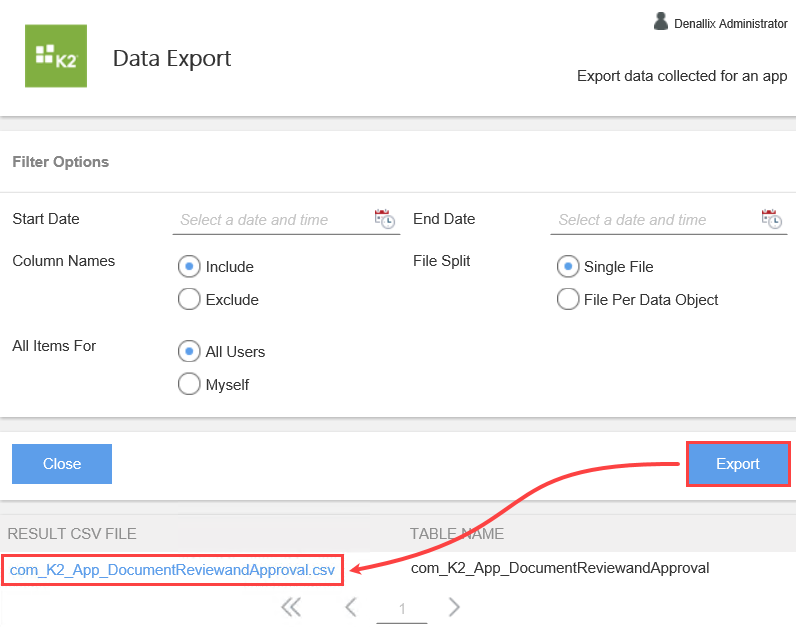

- On the Document Review and Approval landing page, click Reporting.
-
From the All Instances report, drill down into the Process Instance Detail report. To launch this report, click the ID link for any instance. Review the overview bar. In the Activities section, click the Initial Request Review link to launch the Activity Instance Detail report. From this report, locate the Participants section. Review who performed this task, the length of time it took to complete and finally, the action decision they made.
- The All Instances report has drill down functionality allowing you to open more detailed reports for each workflow instance. From here, you can drill down and view the details of a particular step, which is what you will do next. Return to the All Instances section, then click the ID link for any completed instance.

- Review the overview bar. You can see the start and finish times, along with the duration. Just below the overview bar is a summary of the instance, for example, who started the instance, its current status and the priority.

- Scroll down to the Activities section. You can see the status for each step in the workflow, along with the time it took to complete the step. Click the Initial Request Review link. On the Activity Instance Detail report, scroll down to the Participants section. Here, you can see who actioned the Initial Request Review task (Denallix Administrator), the time it took (1 hr 40 min) to complete and the action decision (Approve).


- At the bottom of the screen, click Close. You return to the Document Review and Approval landing page.
- The All Instances report has drill down functionality allowing you to open more detailed reports for each workflow instance. From here, you can drill down and view the details of a particular step, which is what you will do next. Return to the All Instances section, then click the ID link for any completed instance.
- In this section, you learn about the administration features for the Document Review and Approval application. You edit existing properties and change the recipient for a task step. You confirm the changes by submitting a new request.
Begin by launching the application from the BUILD > All menu. From the ALL APPS screen, click Administration. Edit the categories and add a new category called Learning Tutorial. Make its sort order 5. Edit the Second Approval task recipient and change it from Bob Maggio to Codi Kaji. (Once again, if working in your own environment, select a user that can help you test.)- On the Document Review and Approval landing page, click Administration.
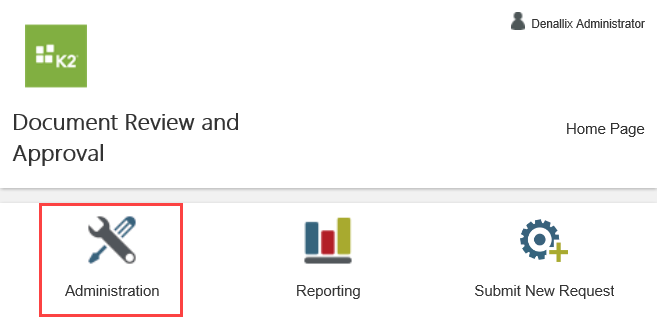
- Administration options vary, depending on the application type and template. In this case, you have two options: Category and Second Approval. First, you will edit the categories and add a new option. Then, you change the second approval task recipient from Bob to Codi.
Begin by clicking the Add button in the Category pane. In the SORT BY text box, enter
5
then for the TITLE, enter
Learning Tutorial
then click Save.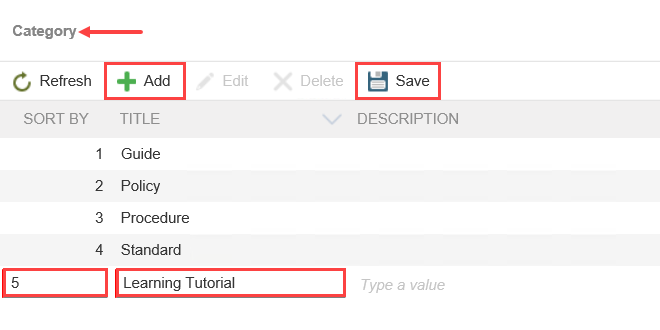
- Next, you change the second approval task recipient from Bob Maggio to Codi Kaji. In the Second Approval pane, click to highlight K2:DENALLIX\Bob. Click Edit. The text box turns into a (people) picker control.

- Delete Bob's name and enter
Codi
then click the Resolve icon. The recipient should now reflect Codi Kaji. Click Save. (Remember, if you are working in your own environment, select a user that can help you test.)
Your Administration landing page should look like the image below.
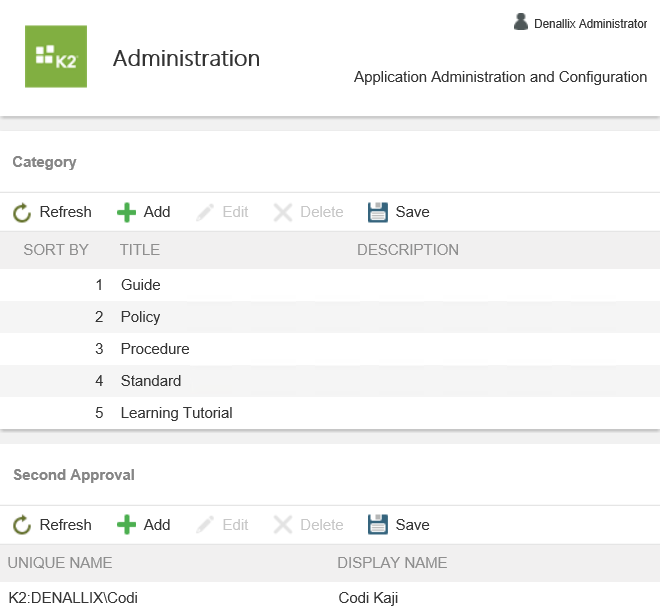
- On the Document Review and Approval landing page, click Administration.
-
Next, you will test the application to verify your changes. From the Document Review and Approval landing page, submit a new request. When completing the form, confirm you can see the new category, Learning Tutorials. Use your own account for the Workflow Approver value. (This is Administrator if you are working on a K2-provided VM.) After you submit the form, open Administrator's Inbox. Open the form and approve the first approval task. Using the User Shortcuts, open Codi's workspace and approve the second approval task. (Codi is in the Human Resources group.)
- From the Document Review and Approval landing page, click Submit New Request. (You may have to launch the application again from the BUILD > All menu.)

- Complete the form fields and upload a test document. Confirm the new category, Learning Tutorial, appears in the Category drop-down list. For the Workflow Approver value, use your own account. If you are working on a K2-provided VM, this value is Administrator. Submit the request.
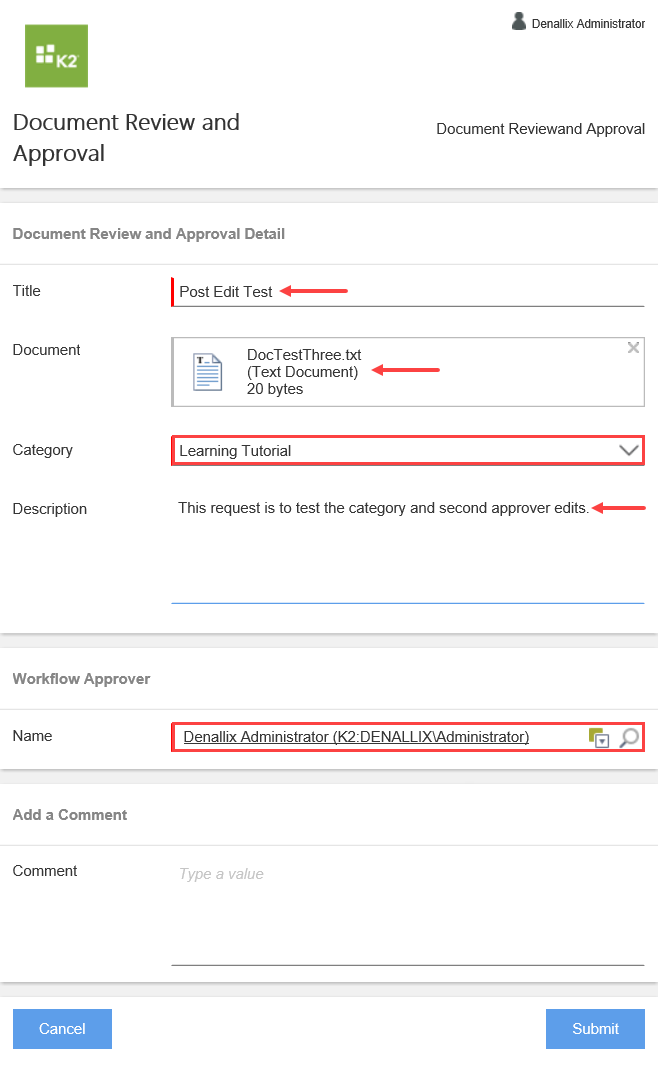
- Now, you will open your task via the inbox. Click the Inbox link in the left column. You should see the Initial Request Review task notification email. Click the email title to expose the task form in the central pane. Approve the request, then submit the form.

- Now, you will confirm Codi has the second approval task assigned to her. Use the User Shortcuts to open Internet Explorer in Codi's name.
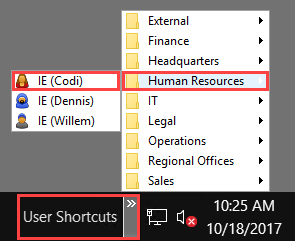
- Launch another instance of K2 Workspace. (Using the start menu: Start > K > K2 > K2 Workspace. Using a URL: https://[K2Environment]/workspace. For example: https://k2.denallix.com/workspace.) Click Inbox in the left column. Find the task notification email for the second approval task (Final Request Review). In the central pane, approve the request, then submit the form.
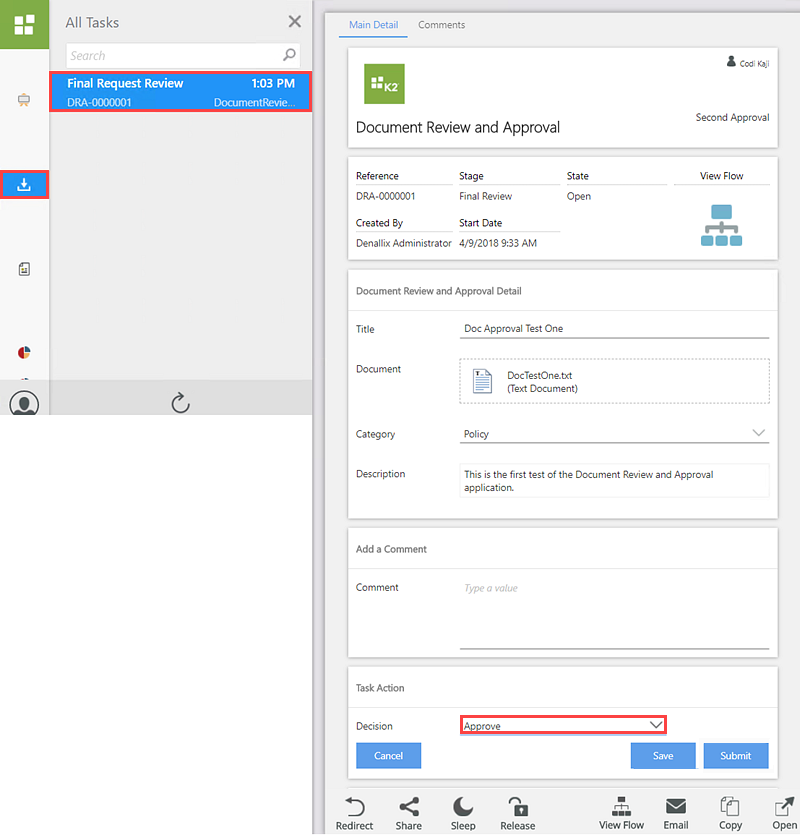
- From the Document Review and Approval landing page, click Submit New Request. (You may have to launch the application again from the BUILD > All menu.)
Review
In this tutorial, you created the Document Review and Approval application from the Approval application wizard. Templates provide predefined data fields that you can customize by adding, editing, and deleting data fields. There are four workflows to choose from including one step approval, one step approval with rework, two step approval, and two step approval with rework. You use the application by submitting a new request, then taking action on tasks assigned to the recipients. There are two reports for the approval application: Process Overview Report and Export to CSV. The Process Overview Report allows you to view data on workflow instance activity where you can drill down to step level details, including task recipients and decisions. Export to CSV export the workflow instance data to a CSV form, which you can open in software such as Excel. Finally, you learned how you can administer this application by updating lookup data fields and by changing task recipients.
-
(Optional) In this step, you delete the Document Review and Approval application from your Workspace environment. For example, if you are working in a shared environment where there are multiple builds of the same application, you may want to delete your applications after use to keep the environment neat and tidy.
From the Build > All > All Apps screen, delete the Document Review and Approval application.- In K2 Workspace, click Build > All to open the All Apps screen.
- Select the Document Review and Approval application and click the Delete button. Click OK for the confirmation.
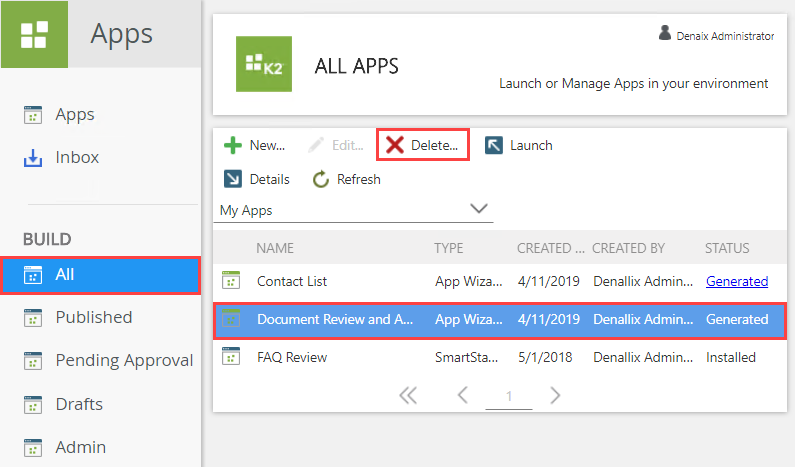
- If the app doesn't immediately disappear, you may see the status change to Pending Delete. Wait a few minutes and click the Refresh button. The application is no longer displayed in the All Apps list.